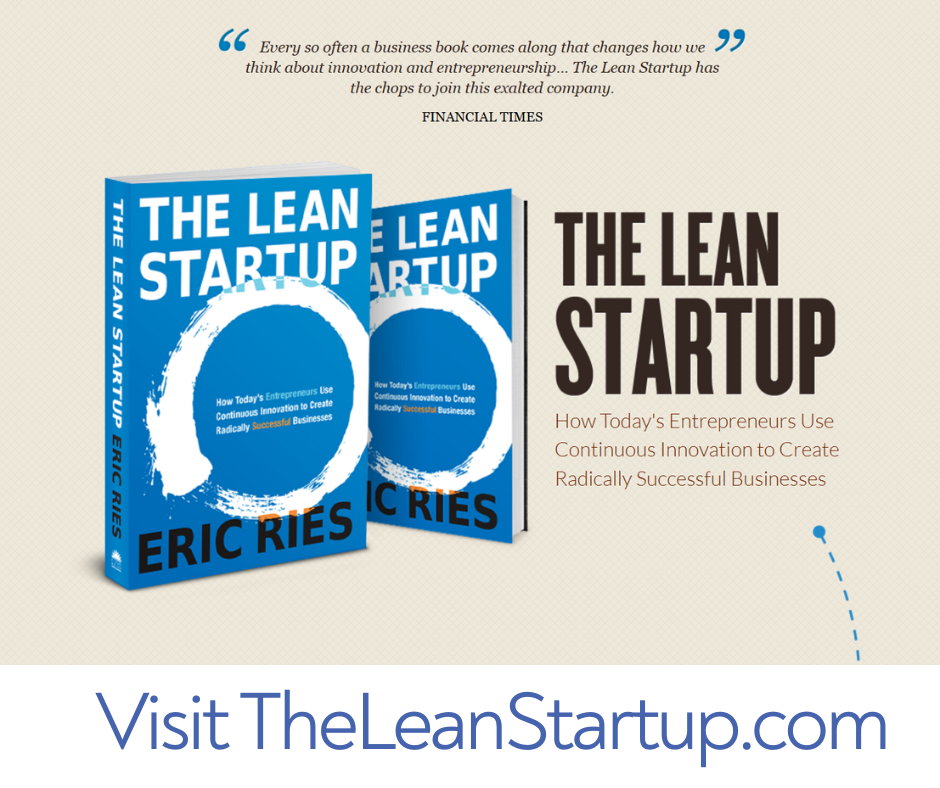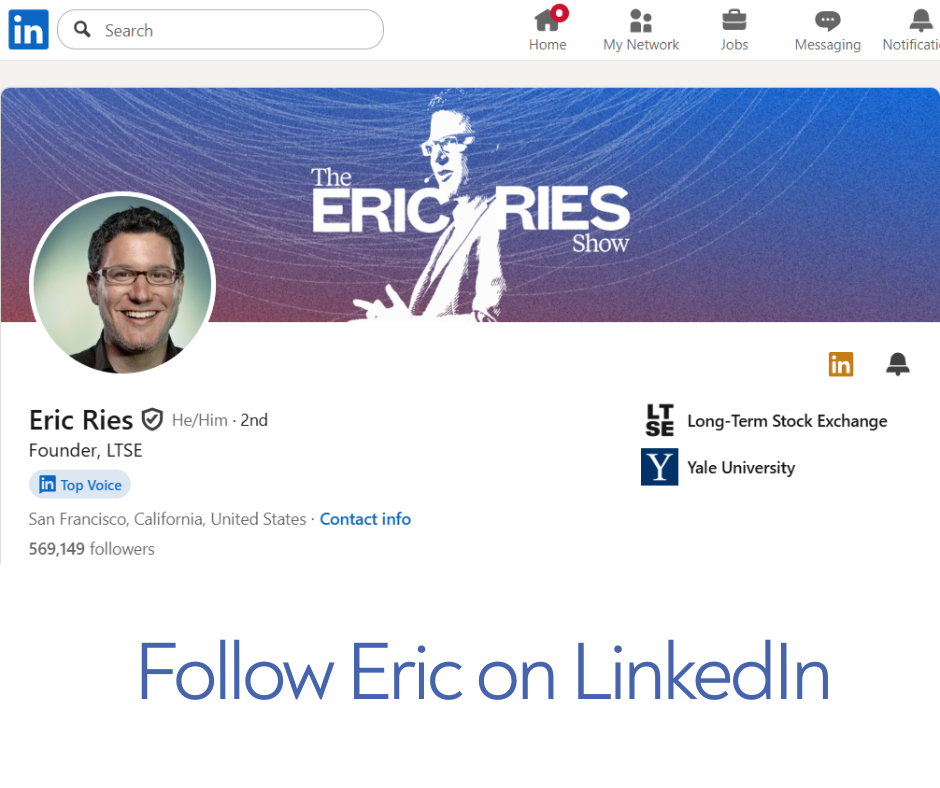NO. 2 Fall in love with the problem, not the solution >
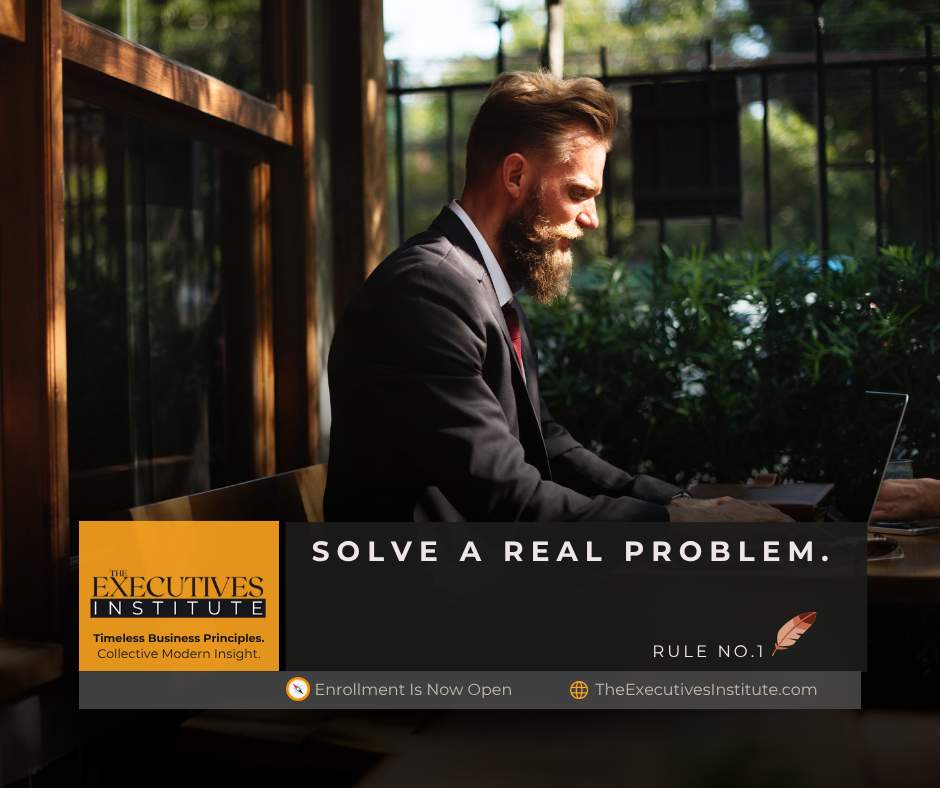
RULE NO. 1 SUMMARY 🪶
If your product, service or strategy isn’t solving a real problem for a real person, it’s a vanity project – not a business.
Painkillers outperform vitamins every time.
Why is this Rule No. 1? Because, without a problem worth solving, everything else is wasted effort.
Businesses don’t fail because their founders didn’t work hard enough. They fail because the work wasn’t aimed at something real. Something felt. Something worth paying for.
Rule No. 1 is where every enduring business begins: Identify the problem your customers can’t ignore—and prove that your solution matters. If you can’t do that, nothing else you build will matter either.
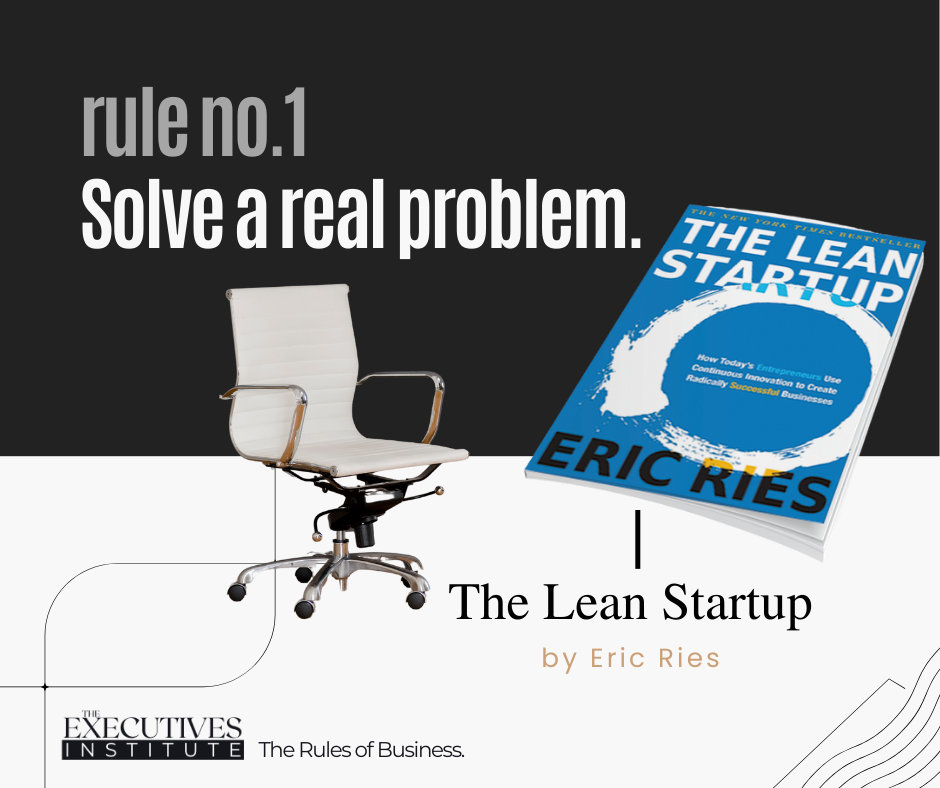
📚Recommended Reading
The Lean Startup by Eric Ries
“The goal of a startup is to figure out the right thing to build—the thing customers want and will pay for—as quickly as possible.”
– Eric Ries
📘Book Summary
A modern classic on building businesses that learn before they launch. The Lean Startup presents a methodology for building businesses and launching products more efficiently, especially under conditions of extreme uncertainty. Eric Ries emphasizes rapid experimentation, validated learning, and agility over rigid business planning. Drawing from his experiences in Silicon Valley startups, he proposes a systematic, scientific approach to creating and managing successful startups.
Executive Takeaway from The Lean Startup
The Lean Startup teaches leaders to replace guesswork with continuous learning—testing ideas quickly, measuring what matters, and adapting fast. Success comes from solving real customer problems, not from perfecting a product no one wants.
More quotes from The Lean Startup:
- “The question is not ‘Can this product be built?’ Instead, it is ‘Should this product be built?'”
- “No business plan survives first contact with customers.”
- “An MVP is a strategy and process to achieve learning and discovery.”
- “The product is the ultimate manifestation of the vision.”
- “The most successful entrepreneurs are the ones who learn the most, not the ones who fail the most.”
- “The only way to win is to learn faster than anyone else.”
- “Entrepreneurship is management. It’s not just about creativity and vision; it’s about structure and process.”
- “The engines of growth for startups are learning and innovation.”
- “In a lean startup, instead of being organized around traditional functional departments, companies are built around cross-functional teams.”

As the key decision-maker of your organization, this rule helps you with:
- Validating new business ideas.
- Pivoting from passion project to viable product.
- Focusing MVP development.
- Avoiding expensive product flops.
- Grounding innovation in real-world pain points.
Here’s a scenario…
An entrepreneur builds an app to help people find gourmet coffee while traveling. Beautiful UX. Slick marketing. Burned through $200K. No one used it — because no one needed it. Coffee lovers already had Yelp, Google, and each other.
Meanwhile, a competitor built a clunky SMS-based tool to help people refill prescriptions in rural areas. It looked terrible, but it worked. It solved a real, painful problem — and they scaled into seven figures in under a year.

The difference? One chased a cool idea. The other solved a meaningful problem.
Business isn’t about invention — it’s about relevance.
When you start by identifying pain points, everything else (product design, messaging, growth) becomes clearer — and more effective.
Rule no. 1: Solve a real problem.
Even the most experienced leaders sometimes fall in love with a solution instead of getting obsessed with the right problem and miss the warning signs that you may be off track.

Here are 10 red flags you might be solving the wrong problem…
1. Customers are customizing your product more than using it as-is.
🚩 — They’re adapting it to their real need — not yours.
2. Your value proposition takes more than 15 seconds to explain.
🚩 — Confusion often means you’re solving something too abstract or irrelevant.
3. Your most engaged users aren’t your original target audience.
🚩— You may have discovered a different (and better) problem to solve.
4. You’re adding features faster than you’re gaining traction.
🚩 — This is often a symptom of solving symptoms, not causes.
5. Sales teams are improvising workarounds or messaging.
🚩 — If they can’t sell it cleanly, the problem may not feel urgent or real to customers.
6. The “problem” you’re solving feels theoretical, not felt.
🚩 — If it doesn’t show up in their calendar, wallet, or stress level — it’s not urgent.
7. User behavior contradicts what they say they want.
🚩 — People may tell you the problem, but their actions reveal the real one.
8. Customer retention is low, even though satisfaction surveys look good.
🚩 — A band-aid solution can earn good reviews — and still miss the mark.
9. You’re solving a problem of your past, not your customer’s present.
🚩— Founders often create solutions based on personal pain points — but markets move on.
10. You’re focused on differentiation, not relevance.
🚩 — Being different doesn’t matter if you’re not solving something real and useful.

 Ask The Right Questions appears with each rule throughout The Institute, designed to challenge assumptions, surface blind spots, and drive clearer thinking.
Ask The Right Questions appears with each rule throughout The Institute, designed to challenge assumptions, surface blind spots, and drive clearer thinking.
 What was the real-world problem that first inspired the creation of our company or product?
What was the real-world problem that first inspired the creation of our company or product?
The Origin Story Example: Sara Blakely (Spanx) solved the problem of uncomfortable or unflattering undergarments by cutting the feet off her pantyhose. Real problem, scrappy solution, massive outcome.
 What was the ‘real problem’ we saw that others in our industry were overlooking or misdiagnosing?
What was the ‘real problem’ we saw that others in our industry were overlooking or misdiagnosing?
The Market Misalignment Example: Airbnb solved the problem of trust in home-sharing — not just lodging access.
 When did we realize our company was solving the wrong problem — and what changed when we pivoted?
When did we realize our company was solving the wrong problem — and what changed when we pivoted?
The Strategic Shift Example: Slack began as an internal tool at a gaming company solving communication issues — the game failed, but the real problem solved was how teams talk.

An Executive Discussion Prompt appears with each rule throughout The Institute to bring to light the shifts your leadership team might need to make next.
The best executive discussions don’t center on strategy decks — they center on hard truths. This rule invites leaders to step back and ask a question that cuts through complexity: Are we solving a real problem, or just building around one?
Discuss: In our current business model, what problem are we truly solving — and is it still the right problem?
Add these follow-up questions to deepen the dialogue:
- Has the original problem evolved — but our solution hasn’t?
- Are our customers buying our product for a reason different than we think?
- What assumptions are we making about what our market really needs?
- If we had to start over today, would we solve the same problem?

Each Rules to Results Workshop is built for your leadership team to dissect one rule, debate the insights, and walk out with clarity—not just theory.
One rule, one conversation, one shift that moves your business forward.
Always under 60 minutes.
WORKSHOP No. 1 Solve a Real Problem
Objective:
Help your leadership team identify whether your business (or a specific initiative) is solving a real, urgent problem — and if not, realign your focus.
Time Required:
45–60 minutes
(Designed for exec teams, department heads, or cross-functional groups)
✅ Materials:
- Whiteboard or shared document
- Printed or digital copies of the “Red Flags” list (optional)
- Timer
- Brutal honesty
🧭 Workshop Agenda
1. Kickoff (5 minutes)
“The businesses that endure solve a problem people actually have. Let’s take a hard look at what we’re really solving — and if we’re still on target.”
- Briefly introduce Rule No. 1 and the purpose of this session.
- Optional: Read the Eric Ries quote aloud.
2. Identify the Problem (10 minutes)
Ask each participant to silently write down:
- What they believe is the core problem your company or team solves.
- Who experiences it, when, and how.
Then: Go around the table. No debate yet — just share.
3. Spot the Disconnects (15 minutes)
Facilitator asks:
- Where do we see agreement? Where are we miles apart?
- Are we describing the customer’s actual pain — or our solution?
- Use the “Red Flags” list to pressure-test your answers.
Highlight 2–3 disconnects worth exploring.
4. Case Study Contrast (10 minutes)
“Where are we solving a symptom instead of the root problem?”
- Identify one product, service, or internal initiative.
- Ask: What problem is this really solving?
- What customer behavior tells us it’s not the right problem?
5. Turn Insight Into Results (15 minutes)
Use these prompts:
- What’s one area where we need to revisit the problem we’re solving?
- What’s one experiment or customer convo we can do this week to learn more?
- What’s one thing we’re doing that might be masking the real issue?
Record clear next steps.
🔁 Optional Follow-Up:
Revisit this conversation quarterly to keep the team problem-focused.
Assign one leader to validate a top customer assumption this week.
![]()
Actionable Strategies 🔁
How do we keep our team focused on solving real customer problems — not just adding features or chasing trends❓
Staying problem-oriented is one of the most powerful disciplines a team can adopt. It keeps work grounded in purpose, guides better decisions, and prevents wasted effort. Use this section to help your team stay focused on solving real customer problems.
1. Start with the Problem Statement 🔍
- Ensure every project, feature, or sprint begins with a clearly articulated customer problem.
- Use frameworks like Jobs To Be Done or problem-centric user stories: “As a [user], I need to [do X] so that I can [achieve Y].”
- Ask: “What pain point are we solving?” — and who feels it most?
2. Make Customer Empathy a Ritual
- Use real customer quotes, videos, or complaints in team meetings.
- Regularly schedule customer interviews or shadowing sessions.
- Share “Customer of the Week” stories that highlight struggles and feedback.
3. Ask “Why?” — Relentlessly
- Use the 5 Whys method to get to the root of every request.
- Don’t take feature requests at face value; ask what problem it solves.
- Teach teams to be skeptical of solutions not tied to a problem.
4. Measure Problem Impact, Not Just Output 📊
- Use KPIs that reflect problem-solving: reduction in support tickets, task completion rate, NPS tied to specific workflows.
- Reward impact, not activity. Praise when problems are avoided or simplified, not when features are just “shipped.”
5. Say “No” — Clearly and Often 🛑
- Create a public “Not Doing List” to document shiny object requests you’ve declined and why.
- Train your team to defend focus with data, not opinions.
- Protect roadmaps from bloat by tying every initiative back to a validated problem.
6. Close the Feedback Loop
- After launching a feature, circle back to the original problem: Did we solve it? How do we know?
- If not, iterate or remove the feature. Let the team see that solving is the goal, not just shipping.
7. Instill a “Problem-First” Culture
- Celebrate questions more than answers in team discussions.
- Appoint a “Problem Owner” for initiatives — someone whose job is to ensure the team doesn’t drift into solution-for-solution’s-sake mode.
- Make your value proposition about customer outcomes, not product bells and whistles.
 Key Takeaways for business owners
Key Takeaways for business owners
- Build-Measure-Learn Loop
- Start with a Minimum Viable Product (MVP)—the simplest version of your idea.
- Release it quickly to test assumptions and gather real-world feedback.
- Use the data to learn what works and what doesn’t, then iterate.
- Validated Learning
- Don’t just guess or assume—test hypotheses with customers.
- Every product, feature, or campaign should contribute to validated learning.
- Pivot or Persevere
- Be willing to make a pivot (a fundamental change in strategy) if something isn’t working.
- Or persevere if data shows you’re on the right track—just refine and scale.
- Innovative Accounting
- Traditional metrics (like vanity metrics) can mislead.
- Focus on actionable metrics that directly relate to user behavior and product success.
- Continuous Deployment & Split Testing
- Launch small, frequent changes and test variations (A/B testing) to understand user preferences and behavior.
- Entrepreneurship = Management
- Startups need a new kind of management system—one focused on agility, learning, and adaptability rather than control and planning.
- Lean Thinking Isn’t Just for Startups
- Established businesses can use lean principles to innovate internally and launch new products with less waste and better customer alignment.
The Lean Startup | Eric Ries | Talks at Google
58:08
🔑 Key Business Terms for Rule No.1
- Problem-Solution Fit
The alignment between a clear customer problem and the solution your business offers. - Minimum Viable Product (MVP)
The simplest version of a product that allows you to test whether you’re solving a real problem for real users. - Validated Learning
Learning grounded in data and user behavior — not assumptions or internal opinions. - Customer Discovery
The process of interviewing and observing potential users to uncover what problems actually matter to them. - Iteration
Making continuous improvements or pivots based on what you learn — quickly and with minimal waste. - Early Adopters
The first group of customers who feel the pain most acutely and are most eager for a solution. - Vanity Metrics
Numbers that look impressive (like page views or downloads) but don’t indicate whether you’re solving a meaningful problem. - Pivot
A structured course correction designed to test a new hypothesis about the product or business model.
Real-World Examples of “solve a real problem” to share with your leadership team
🥿 Zappos – Validating Online Shoe Sales – Instead of investing in inventory, founder Nick Swinmurn tested demand by photographing shoes from local stores and posting them online. When someone bought a pair, he purchased it at retail and shipped it himself. The demand was real—Zappos was born.
📂 Dropbox – Testing Demand with a Simple Video – Before building the product, Dropbox created a short explainer video to demonstrate how it would work. It led to thousands of sign-ups overnight, validating interest before a single line of backend code was written.
🏠 Airbnb – Monetizing Extra Living Space – Struggling to pay rent, the founders hosted guests on air mattresses during a local conference. The experience uncovered a huge demand for affordable, short-term stays—and led to the creation of a hospitality giant.
💳 Stripe – Simplifying Online Payments – Online payments were a developer’s nightmare. Stripe’s founders launched with a few lines of code that made integration effortless. Solving that technical bottleneck made Stripe the go-to platform for startups.
💻 GitHub – Streamlining Code Collaboration – Developers were emailing code back and forth—inefficient and error-prone. GitHub built a collaborative platform around Git, making version control easy and enabling open-source to thrive.
💵 Wagestream – Reducing Financial Stress Between Paychecks – Recognizing that many workers live paycheck to paycheck, Wagestream let employees access earned wages instantly. A simple fix to a widespread problem—and a hit with employers and workers alike.
🧬 Rare Genomics Institute – Connecting Rare Disease Patients with Researchers – After meeting a child with an undiagnosed illness, Dr. Jimmy Lin launched RGI to crowdfund research into rare conditions. They turned one family’s struggle into a platform for thousands.
🎨 Penpot – Bridging the Gap Between Designers and Developers – Designers and developers were often out of sync. Penpot created a collaborative tool both teams could use—solving friction at the root of the product development process.
These Startups Didn’t Guess. They Solved.
Before scaling, these founders took one critical step: they solved a real problem. Whether it was hosting guests during a conference or simplifying a nightmare integration, these companies found pain points and built with purpose. Their stories prove that timeless principles—like solving something real—still drive the most lasting results.
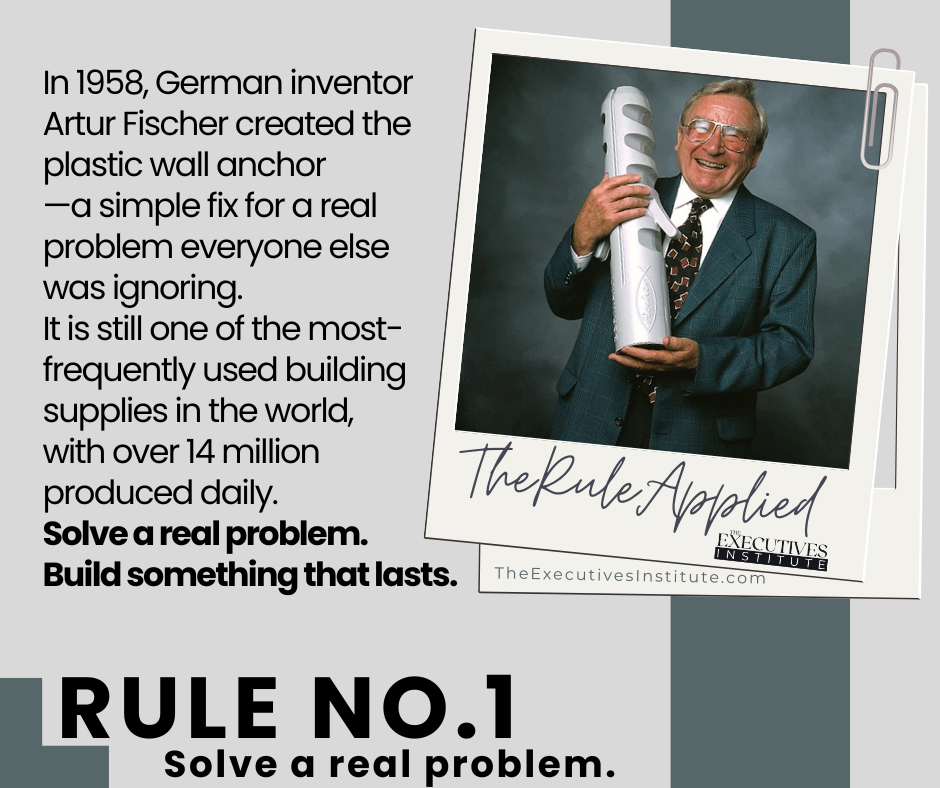
If you’ve used an airline check-in kiosk, Jeff Hoffman’s ingenuity has already impacted your life! Jeff is a serial entrepreneur known for Priceline.com, Ubid.com and branching out into the entertainment space to apply his signature brand of entrepreneurship to those industries as well.
Jeff provides his first key to success in entrepreneurship, that your startup should solve real problems. While most people simply complain when they encounter a problem, entrepreneurs try to solve it! He also uses the example of Webvan, one of the first home delivery startups, and the story of its bankruptcy to articulate why your startup should solve a real problem that your customers are willing to pay for.
Member Insights

“The turning point in my career came when I stopped asking, “What am I good at?” or “What can I build?” and started asking, “Whose life can I make better?” Every lasting business I’ve seen was born from that shift. Solve something real for someone real, and they’ll not only buy from you—they’ll become your biggest advocate. That’s where growth begins.”
– Kurt McSparron, Founder The Executives’ Club Fargo-Moorhead
💬 TELL US YOUR STORY: Become an Executives Institute Contributor.
Some of the most impactful businesses didn’t start with a big idea — they started with a real problem someone couldn’t ignore.
We’re looking for short stories, insights, or turning points from CEOs, founders, and business leaders that answer one simple question:
What real problem did you decide to solve — and how did that change everything?
Whether it was the spark that launched your company, a strategic pivot, or a lesson learned the hard way, we want to hear the moment you realized this was the problem worth solving.
Optional follow-up questions to consider:
- How did you first discover the problem?
- What made it “real” enough to act on?
- Were others solving the wrong problem?
- How did solving it change your business trajectory?
Submit your story in 300–600 words, or record a short video or voice memo.
We’ll feature select submissions on this page— highlighting the timeless business rule behind every great move: solve a real problem.
What seems obvious to you today might be the spark that changes someone else’s path tomorrow.
At The Executives’ Institute, we draw from the deep well of experience—hard-won insights, defining failures, and the real turning points that shaped today’s leaders.
The insight you share might be the turning point someone else is waiting for. ADD YOUR INSIGHT

🏛️ You’re early — and that’s a good thing.
This Rule page is still under construction as we continue building The Executives’ Institute, moving in both the Startup to Scale order and our Weekly Rule program. We invite you to add your insight now—your experiences and lessons will help shape how this Rule develops, ensuring it reflects not just timeless fundamentals, but also the real-world perspective of leaders like you.
The Executives Institute is brand new, as of June 1, 2025, and we’re building as we go. More pages and insights are being added every day. If a Rule resonates with you, we invite you to contribute your experience and become a Collaborator. Your voice will help shape the future of The Institute. Know someone who would add value here? Invite them to join — the more Members, the more Collaborators, the stronger the insight.
🏛️ HOW WE PRACTICE WHAT WE PREACH at The Institute
We built The Executives’ Institute to solve a real problem we saw over and over again.
For 20+ years, we sat across the table from CEOs, founders, and business owners who were facing high-stakes decisions — but didn’t have time for another course, didn’t trust trendy advice, and were tired of business books that offered more fluff than substance.
So we asked:
What if there was a way to cut through the noise and surface just the timeless principles — the ones real leaders actually use?
That’s the problem we set out to solve.
We’re not here to add to the noise. We’re here to help you think sharper, act faster, and build better by giving you:
- A living library of business rules that actually hold up in the real world
- The best book behind each rule, so you don’t have to read 20 to find one worth your time
- Executive conversation starters, so you can turn ideas into action with your team
The Institute exists because the problem was real. And so is our commitment to solving it — with you, and for you.

